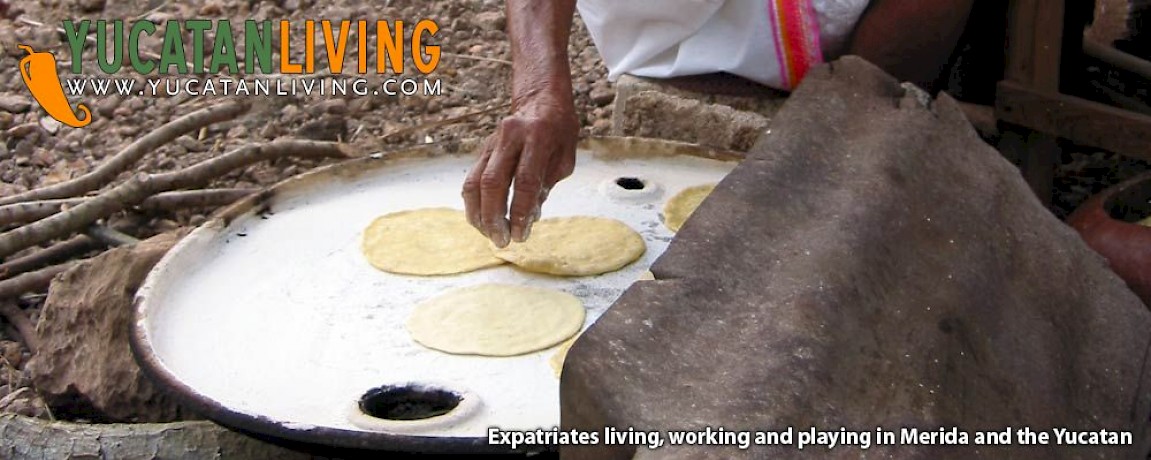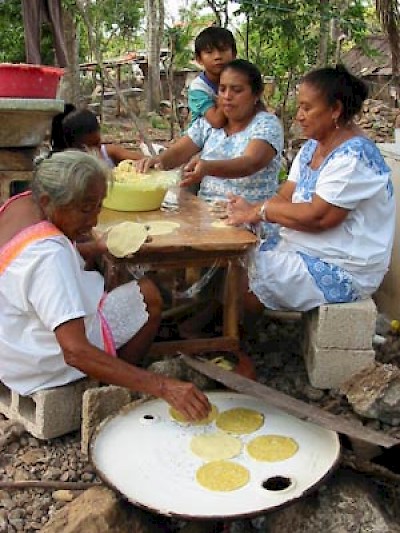How To Make Panuchos and Salbutes
Where's the Mexican Food?
Anyone who lives here will tell you that one of the best things about living in the Yucatan is the food. When we visited here and bought a house, we were still clueless about Yucatecan cuisine... we had no idea about the treasure trove of tastes and delights that we had stumbled into. Our idea of Mexican food was formed in California, where Taco Bell and chicken enchiladas rule the day. So imagine our surprise when we couldn't find a quesadilla or a burrito to save our souls (or our stomachs), but instead were presented with tiny little tortillas and things like castacan and cochinita. What the hey?
As in many cultures, the food was another avenue of learning for us about the unique place that Yucatan holds in Mexico and in the world. And learn we did.
Fast forward seven years and now we're very practiced at eating everything from that aforementioned cochinita and castacan to pavo relleno negro and papadzules. We know what a pib is and we can tell the difference between a habanero and a xcatic.
In the interest of passing on our hard-won knowledge, we plan to bring you a recipe from time-to-time. Some will be reproduceable, others might just be for show. The food here is not just full of flavor, but it is full of stories too. We are not cooks by profession, but we tend to eat rather regularly. And we love a good tale as much as a good table.
Here, then, in response to a request that was sent to Yucatan Living recently, is how we have learned that one can make authentic Yucatan panuchos and salbutes.
How To Make Panuchos
1. Sharpen your machete, stroll casually into your backyard and select a healthy pollo (chicken) or, if it’s a special occasion, a pavo (turkey). Using the machete, remove the head. Let drain. Deposit in a bucket of warm water for several minutes until the feathers can be easily removed by your eldest daughter. Remove feet and internal organs. Wash thoroughly.
2. Pick some naranjas agridulces (sour oranges) from your tree and squeeze the juice into a bowl. Add achiote (annatto paste) until thickened. Add sal (salt) to taste. Spread generously over the bird inside and out. Wrap bird in moist hojas de platano (banana leaves).
3. Remove your son’s soccer ball from your pib (the one- to two-foot-deep baking hole you’ve dug in the back yard). Start a wood fire in the pib and let burn until you have a floor of glowing red embers. Spread two to three centimeters of moist earth over the embers. Deposit the pollo in the pib and fill the hole with dirt. Let bake until done, usually 1 to 2 hours depending on the size of the bird (more time is required for a standard pavo).
4. Send your wife, suegra (mother-in-law) or the woman in your family with the smallest hands next door to the Maseca, Sumasa or Minsa tienda (store) to purchase half a kilogram (about a pound) of harina de maíz (corn flour), more commonly called masa. She will know to mix this slowly with water (roughly two cups masa with 1/4 to 1/3 cups water), while kneading the dough into a ball.
5. Cut off the bottom of a 50 gallon oil drum and prop it about a foot off the ground with large stones on two sides. Start a wood fire underneath. Wait until any oil or other residue on the metal is burned away before using.
6. Your wife, suegra, hermana (sister) and a few other women in the family will sit around a table. Each will portion about two tablespoons of masa dough from the ball and pat into a tortilla using nothing but her tiny hands. The resulting tortilla will be about four inches in diameter, maximum.
7. She will set the raw tortillas, two at a time, on the hot metal comal (grill) constructed from the 50 gallon drum, letting them cook for about 30 to 45 seconds on each side. If she is planning to make panuchos, she will tamp them down a bit around the edges with an index finger (the tortillas tend to inflate when you do that). When each tortilla is finished cooking, she will deposit them in her lek (round, dried, hollow gourd with the top cut off), which has been lined inside with a clean, brightly-colored kitchen towel. Keep covered.
8. Remove the baked bird from the pib and let cool. Your second daughter will shred the meat from the bird by hand into short strips about two centimeters long with the circumference of a soda straw. Keep the shredded meat in a bowl and cover. Don’t forget to remind your daughter to wash her hands before and after.
9. Squeeze the juice of several limones (Yucatan lemons, which are more like limes) into a small bowl. Add finely-diced habanero chile picked from the bush growing next to the front door and, optionally, finely-diced cilantro.
10. By now, your youngest daughter (or perhaps the friendly wife of a neighbor) has diced some jitomates (tomatoes), pepinos (cucumbers),aguacates (avocados) and maybe lechuga (lettuce). Someone has brought out a bowl of cebolla morada (purple onions), previously sliced and marinated in naranja agria.
11. Now it's time to make a panucho. Take a warmed, cooked little tortilla balloon, and slit it open enough to deposit a spoonful or two of black bean paste inside. Drop the tortilla into a pot of hot oil and deep fry it.
12. Remove the now-crispy tortilla, place it on your plate, layer on lettuce, shredded chicken or turkey, cucumber, cebolla morada, tomato and avocado, in that order. Sprinkle habanero sauce over all, if you like to sweat and pant while you eat. That's a panucho!
13. Eat and enjoy, probably with a side of ice-cold Mexican Coca-Cola.
Would you Rather Have a Salbute?
Then skip Step 7. Drop the fresh uncooked tortillas directly into the hot oil for deep frying. The resulting tortilla will be softer, and will not be puffed up like a balloon. Skip Step 11 and go directly to Step 12. That's a salbute!
Repeat Step 13. Often.
Buen provecho!











Comments
ingrith 15 years ago
If preparing a panucho sounds like lots of work, don't worry, there's this place in LA ALEMAN, on 26th avenue across from Aleman Park, almost across from IZA drugstore. The name of the store, if i'm not mistaken, is "EL PANUCHO DE KANASÃN". One panucho will fill your stomach because they're not big, but tall! They have a lot of turkey meat and many traditional things to dress them.
Another place in LA ALEMAN, is la "TERRACITA DE LA ALEMAN", in front of the Cano y Cano school and the OXXO. Ohh, the best panuchos ever! Get the "pico de gallo sauce" to put on your salbutes or panuchos and a fresh Horchata. You should also ask for their delicious "cáldo de pavo" (turkey soup) or a "vaporcito" (a small tamal) to finish your dinner. If you prefer you can also get a "Colado" another tamal, which is softer and better.
If you're thinking of visiting Mérida, el MERCADO DE LA ALEMÃN is also a good option if you want all this stuff as breakfast.
Reply
Mark & Dawn 15 years ago
My wife and I have had the privilege of traveling throughout the Yucatan peninsula every year for nearly 20 years. We have always marveled at the food, and always felt sorry for the gringos who went to the high class restaurants instead of eating the street food or going to the cocinitas. There is a particular tiny restaurant in Isla Mujeres that serves the best salbutes I have ever run across. The tortillas have such an incredibly aromatic corn flavor that I have never seen duplicated.
I especially like the commentary on how you start the recipe. I have raised small animals in the past for consumption, and your description of starting by saying "Sharpen your machete..." is indeed spot on for how most Mayan folks begin. It all comes down to understanding where your food comes from.
I have just discovered this website, and can't wait to check out the rest of it. Adios.
Reply
Working Gringos 16 years ago
Sounds delicious... glad you skipped the iguana, though!
Reply
jenny wildman 16 years ago
Had a craving for Mexican style food tonight so decided to get inspired on internet. Your article was most amusing and informative but I decided to skip step one of this recipe and reach into my freezer. Half an hour earlier we caught an 5 foot iguana in the vegetable garden and I actually thought about using him but way more work than I wanted . Making the tortillas and toppings was quite enough.
As to step # 4 ........I added Ricado, achiote powder to make the tortillas lovely Orange color.
Extra cold cerveza........hmmmmm
Jenny Wildman
Maya Beach, Belize
Reply
Working Gringos 16 years ago
Good to know! Thanks, Nancy...
Reply
Nancy Gerlach 16 years ago
Fellow Yucateco food lovers. A couple of years ago my husband and I wrote a food and travel book titled Foods of the Maya, A Taste of the Yucatan (available Amazon.) Our traditional recipes include substitutions for ingredients that are difficult to find outside the Yucatan, and methods of cooking that have been adapted to modern kitchens and are less complicated than some of the traditional ones. These recipes may help some of you that are not living in this wonderful part of the planet to duplicate some of the dishes that you've enjoyed here.
Nancy Gerlach
Chelem Puerto, Yucatan, Mexico
Reply
CARLOS DANIEL GALLEGOS 16 years ago
To Nancy, yes, it is hard work to put all the ingredients together and cook honest to good Mexican/Yucateco food. But, once you've done it and have tasted your creation, it is well worth the effort. I remember when me and my brother (Roberto) were small kids. My dad and mom would have us help make the tamales. While we did not like the work, we did enjoy eating the tamales once they were cooked. My dad was a traditionalist when it came to Mexican cooking. He would go to the market and buy a pig/hog head, and cook the meat off it, to make the tamales. His home made chili salsa was the best (when I say chili, I dont mean the Wolf Brand kind. Chili for us is Salsa, like Pace, or El Yucateco Brand is). He used only the best. He would cook the jalepeanos in a pan, until the odor would cause tears (lol), then combind all the ingredients and smash them in a Mocajete or stone bowl. Today's Mexican and Yucateca women hardly make home made tortillas. I was amazed when I saw women in Gran Plaza doing it. I think is was on for Merida En Domingo. My dad, taught my mom (traditional Chicken Fried Steak and Patatoes gringa) how to make Flour Tortillas. She learned very good. Those tortillas were great, hot off the stove, we put butter to melt on it. Some times w springle sugar over them. I miss those days. Yes, Nancy, it is hard work. But, the rewards are wonderful. :-)
Reply
CARLOS DANIEL GALLEGOS 16 years ago
I was reviewing this article, and I thought, Mexican food by any other name is still Mexican food. Just some minor ingrediant variations and name differences. We here in Texas has some thing like Panuchos/Salbutes, which we call Tostadas. No, not the Taco Bell version. My dad (1st generation TexMex) taught us how to take Tortillas de Maiz and deep fry them in grease (yes, real lard like they use in Mexico), till they are crisp. They are round and flat, not folded. Then we top it with ground beef we fried with garlic, onion, tomatoe paste, and other spices. Then we put shreded lettuce and sliced Avocate on top as well. Top that with home made chilie salsa. We have Pinto Bean dip, Yucatecos make black bean dip. I dont mean the 'old El Paso' kind. I mean, we take the beans we cooked over night. Put them in a fryin pan, and smash them with a smasher, until they are dip smooth. Then, we take the fried chips we made eairlier, to dip it with. Granted, the Yucateco Tamale and the Tejano or Norteano Tamale are different. We use Corn Husks, not banana leaves. Weather you are eating home made Yucateco or home made Mexican (not Taco Bell) food. Enjoy it with a glass of Cerveza or coca-cola, and musica tradicional en espanol with familia. It will bring joy to your heart. :-)
Reply
Working Gringos 16 years ago
Thank you for your offer, Tilan Juan. We don't know anyone who is perfect, so you are in good company.
Reply
tilan juan 16 years ago
If someone out there wants to learn how to speak Mayan, perhaps we can chat someday. I live in Oregon. My people know me as Tilan Juan. I am not perfect.
Reply
nancy 16 years ago
Oh boy that sounds like mucho trabajo to me. I think the vendors on the streets are much easier. I wish though that I can have one now but sadly I am back in Canada and they don't let us keep chickens in the backyard where I live.
Reply
« Back (20 to 31 comments)Next »